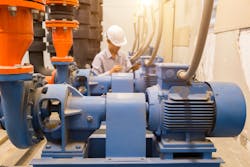With many reporting that a timely return-on-investment can be difficult to achieve due to the large upfront costs Industry 4.0 initiatives sometimes require, retrofitting is often floated as a powerful first step toward digital transformation. Not only does retrofitting older equipment facilitate a “step approach,” to digital manufacturing—it also allows operators to develop small use-cases that increase their familiarity and confidence with new technology. As a result, initiatives that begin with retrofits often evolve into larger, more wholesale transformations.
However, whether or not a retrofit is the right solution and what type of retrofit should be pursued is not always clear-cut. To help end-users parse through the various considerations that need to be made, Automation World recently spoke with Brian St. Jean, presales system engineer at Paessler, and Markus Mediger, product manager at Paessler. Paessler provides monitoring software, and partners with companies that carry out retrofits.
According to St. Jean, the first question operators should always ask is whether or not retrofitting a piece of equipment is the right solution to begin with. As an example, he references a glass manufacturer that was looking to measure the amount of materials being processed to improve throughput. However, on closer examination it became clear that, rather than retrofitting the equipment responsible for these tasks, merely monitoring the operational environment proved far more beneficial to the company’s bottom line.
“The questions you want to ask are where are you trying to go, where are you now, and what information do you need,” St. Jean says. “Then you can start thinking about how to get there.”
For this reason, it’s important to conduct a careful cost-benefit analysis before rushing into a hasty retrofit that might not, ultimately, be worthwhile. For instance, pulling more sensor data from an isolated pick-and-place machine into a monitoring system may seem like a straight-forward prospect, but if the end-user needs to open up the equipment and add new sensor or data collection components, it could void the machine’s warranty and may cause confusion or other difficulties when maintenance professionals service the machine.
In addition, St. Jean recommends weighing the degree to which an asset is mission critical when considering a retrofit.
“A lot of times a factory has multiple pieces of equipment that do the same thing,” he says. “In those cases, you don’t want to spend too much money monitoring them because if one goes down you have two or three others that can pick up the load. It’s not a bottleneck situation.”
And while identifying the appropriate business case for a retrofit should be end-users’ first priority, individual pieces of equipment may also face technology barriers. For example, some older machines may use proprietary systems that do not allow information to be shared through anything other than an onboard human machine interface (HMI).
“When we talk about machines that have proprietary maintenance interfaces that use some kind of serial data meant only for vendor-specific devices, we need to build a custom connector that can translate that serial data into some kind of information technology (IT) connectivity,” Mediger says. “It’s probably going to be very difficult for us to do.”
Ultimately, when the business case is correct and the technology affords it, a retrofit can be a highly advantageous option. Due to the increasing availability of intelligent sensors that allow multiple different process variables to be monitored simultaneously, more data can be attained at a lower cost. Still, according to Mediger, retrofits cannot serve as a substitute for more holistic digital transformation efforts.
“Before you get into these big, complicated investments that come with moving toward Industry 4.0 for flexibility and reconfigurability, retrofitting is a good start to optimize machine health or manufacturing processes. You can gain a lot from a retrofit without a big investment,” Mediger says. “But once you start thinking about scaling to the entire shop floor or introducing a greater variety of products and flexibility, you’re going to need to make a more serious investment if you want to modernize.”
About the Author
David Miller
Former Senior Technical Writer

Leaders relevant to this article:
